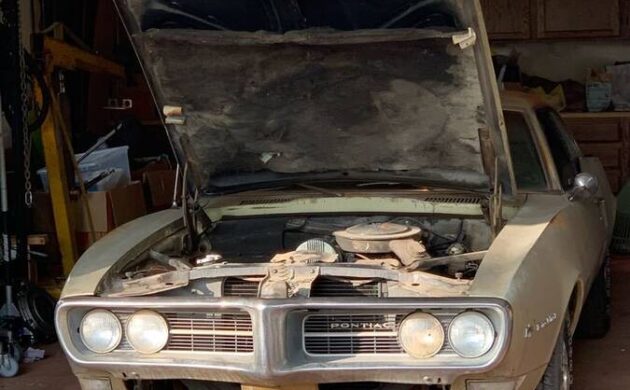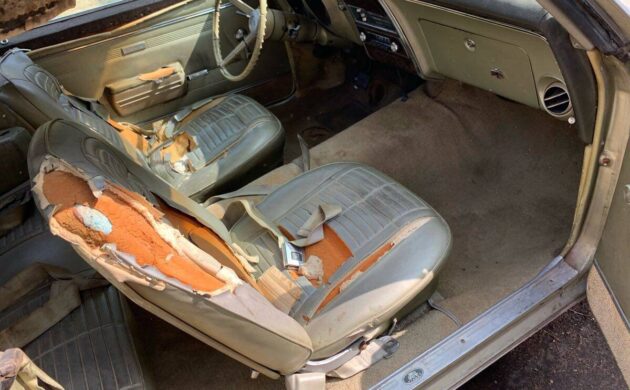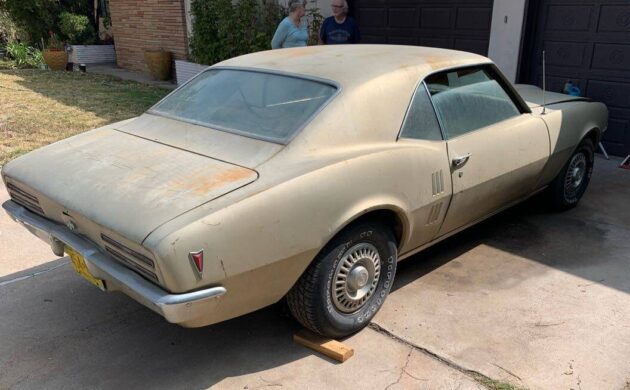The Firebird was Pontiac’s response to the First Generation Mustang, and, like its competitor, it offered an entry-level option for buyers unable to justify the expense of a V8. Many of those cars received later drivetrain upgrades, but this 1968 model is an original and unmolested survivor. Adding to its appeal is its lack of rust issues. That leaves potential buyers with choices to make about the car’s future. Preservation could be one path, while a faithful restoration is another. The buyer could throw caution to the wind and transform the Firebird into the pony car of their dreams. It is listed here on Craigslist in Corrales, New Mexico. The owner has set their sale price at $16,000.
The First Generation pony cars that cross our desks at Barn Finds usually fall into two broad categories. Some are beautifully preserved or restored, while others require significant rust repairs as part of the build process. This Firebird offers an alternative, as it is a rust-free classic. Its panels and underside sport dry surface corrosion, but there is no evidence of penetrating rust. That is a significant achievement and probably due to living in the dry New Mexico climate. The same conditions ideal for preserving classic steel can exact a high toll elsewhere, making the baked April Gold paint no surprise. The vehicle would benefit from a cosmetic refresh, although it would draw the same level of attention and respect if the buyer elected to preserve the car untouched. The condition of the exterior trim is as you might expect for an unmolested vehicle of this age, while the tinted glass looks excellent.
The seller provides no close-up photos of the Firebird’s engine, which is disappointing. While many potential buyers in 1968 found the lure of a V8 impossible to resist, Pontiac’s approach with their pony car mirrored that of Ford with the Mustang. Those who wished to buy into the lifestyle but couldn’t justify or afford an eight under the hood could order their new toy with a six. It provided the stunning looks they desired but in a package that wouldn’t break the bank and provided good fuel economy. Our feature car reflects that thinking, with its engine bay occupied by the original 250ci OHC six-cylinder engine that sent its 175hp to the rear wheels via a three-speed manual transmission. Performance expectations for this configuration would not be high, but the car’s ability to cover the ¼ mile in 17.1 seconds looked pretty respectable. For potential buyers intent on preservation or restoration, there is positive news. The seller recently rebuilt the carburetor, and this classic runs and drives. It is unclear whether it is roadworthy, but if it isn’t, getting it to that point may not be difficult.
Given this car’s baked exterior and paint, opening the door to an interior featuring crispy and crumbling upholstery and plastic is no surprise. The bones of the interior, like the dash and seat frames, are okay. However, the Gold vinyl, seat foam, dash pad, carpet, and headliner are beyond salvation. The obvious solution is a trim kit, and one with everything required to return the interior to a pristine state would cost around $2,000. If the buyer elects to follow the custom build path, they may decide to perform wholesale trim changes. They are only limited by their imagination in such circumstances and may select cloth or leather as their preferred material.
Classics like this 1968 Firebird leave me torn because I can’t decide what approach to take if I found it parked in my workshop. I instinctively lean towards preservation and the rare opportunity it offers to slip proudly behind the wheel of a genuine survivor. The idea of a faithful restoration is equally appealing, while some readers will provide compelling reasons why its rust-free status makes it a prime candidate for a custom build. Regular readers know my preference for originality, but I see the merits in the custom approach. Such a build should be straightforward due to the lack of rust repairs, and I won’t be surprised if that is what the future has in store for this beauty. What would be your choice, and are you committed enough to consider pursuing the dream further?






Always been intrigued by these engines. Had a few running around town back in the day. I would definitely keep it original with some nice upgrades.
Agree, Camvette. This OHC has plenty of potential. Offenhauser makes some great upgrades. like 3 single barrel manifolds. Several speed shops make heads and cams. A guy in my high school (Taft High, Woodland Hills CA) built his LeMans OHC into a beast that was so fast it was featured in Hot Rod magazine.
I’ve been intrigued with the OHC six story, also; but I think the bottom line was, Pontiac did it half-way.
There are sixes, and sixes. In-line sixes in American cars, tended to be cast-iron blocks…heavy and sturdy. Emphasis on heavy. The Jeep six, which started life as the Rambler six in 1964…to replace the American Motors’ aluminum-six experiment…the cast-iron replacement weighed over 600 pounds.
GM’s divisional sixes were lighter, but not that much lighter. These were designed to last, not to be light.
John Delorean’s experiment in creating the second American OHC six (Willys/Kaiser-Jeep was first, with the ill-fated Wagoneer six in 1962)…Delorean’s people took the expected shortcuts. Iron was the material – understandably, as aluminum in engine casting, was an art in its infancy. A head with the cam in it, was the only true departure from tradition.
It breathed better. Maybe much better – I’ve never driven one. But it STILL had all that weight. Was the stroke shorter? I don’t know if they designed it oversquare. But weight is weight, and there was plenty in that engine, in any GM engine of the time.
To benefit from the better aspiration of an OHC design, other aspects would have had to be addressed. It fell to others, mostly Japanese, to do so.
They where also available with a four barrel Quadrajet from the factory with 215 hp
I had a friend in college with a convertible and the OHC. I remember him getting the wrong spark plugs and the piston would hit the plug and close the gap. Otherwise, the engine was great.
He did have trouble finding hydraulic fluid to get the top working again.
I wish I was in the market to buy one because I would be hooking up the trailer to the truck to go get this one. Clean original and rust free that’s hard to come by with one of these. I would want to create a HO version of the OHC and maybe convert from column to floor shift but I would keep the colors original maybe some nice wheels and tires. I got a joy ride in a 68 HO sprint OHC and that car was quick and handled really well.
I concur with first two commenters’ For me, creating a hot-six banger with a stick would be a real nice restoration for this beauty in the rough.
Nice to know if is a Sprint or just the OHC six.
Always wondered if sagging or disintegrating hood insulation could be a fire hazard. Silly option, IMO.
Frustrating to not get a good look at the engine compartment, as well as the trunk which are notorious for rust. Just looking at it makes me want to get my car washing bucket and some rubbing compound, see how far I could bring back the paint! I would agree with the others, keep the original engine and tweak it for more power.
Was hit in the rear. Needs fixing rear panel, bumpers & brackets and probably tweaked the trunk floor at the back.
Otherwise, nice solid car.
16k?, Really? Ho Lee Chit
My uncle had a ‘69 LeMans with the Sprint OHC Six and a floor shift. He bought it new in late 1968.
By 1970 I was into stuffing SBC’s into Shoe Box Chevrolets, cutting a wrecked ‘69 Road Runner and ‘69 Belvedere in halves and welding them together with a hot 383 and acquiring my first car, a 1967 Fairlane GTA S Code but..
I really had an appreciation for Uncle Harold’s LeMans.
It was exotic to me and my only other exposure to anything near to being exotic was my brother-in-law’s ‘58 MGA aluminum body….
That LeMans was quiet, handled great probably due to less weight in front and was more than quick enough considering it was a straight six.
And that engine looked great. Especially when compared to Stove Bolt sixes and Ford sixes with the cast iron logs.
Later in life I researched the Pontiac OHC engine and found that John DeLorean was instrumental in it’s production in that he wanted an engine that was competitive with the BMW inline engines of that era…
https://www.roadandtrack.com/car-culture/classic-cars/news/a4620/go-news-classic-cars-john-z-deloreans-high-performance-high-tech-inline-six/
Dr. Ron,
In 1967, BMW was still an unknown in the States, still digging out from under the rubble of WW II. The four cylinder neue klasse 1600 was a noble effort. I think Delorean’s target was the Jaguar XKE.
The Pontiac’s cam runs in that aluminum carrier, if worn, you lose oil pressure, not sure if they’re being reproduced. See if the seller will provide video of an oil pressure gauge on a warm engine.
Funny, Jeep beat John to market with an OHC Six!
https://en.wikipedia.org/wiki/Jeep_Tornado_engine#:~:text=Six-cylinder%20versions%20built%20after%203%20May%201962%2C%20received,fall%201962%20for%20the%201963%20model%20year.%20
16 grand and needing complete restoration, I’m going to have to pass
Folks, are all inline 6 Firebirds “Sprints”, or is this an example of a non-Sprint inline 6?
Steve Douglas: Not absolutely positive, but believe the Sprint version used a modified intake manifold with a quadrajet (4 barrel) carb, and a split exhaust manifold so you could run true duals. I imagine the cam enjoyed better specs to take advantage of the freer breathing.
I used that motor with a Clifford Research intake manifold for three side draft Webers in my 1953 Studebaker Starliner.
Jay Leno did a great presentation forJL’s Garage. Camshaft train is a serious issue. First cam belt drive GM car.
I saw that, and that’s what got me interested in an OHC. A very nice car, that.
Nice car I would take out the drive train sell it to put the money in the interior . I would put a 400 sb stroked to 439 cu in with a 6 speed manual transmission leave the stock rear end .clean the paint clear it .Now you got a sleeper and yes I have the motor .got a 68 z28 350 x350 waiting for the right build .You asked what someone else might do there’s my 2cents . happy motoring
My first car was a 67 Sprint 6 convertible Bird (no I do not still have it). Mine was red with black top an interior, 3 speed on the floor. That car was so much fun! Surprised many cars with V8’s in them, as they did not expect it to go as well as it did. Handled fantastic, too, outran a Porsche 911 on a back road, as well as a few other cars that were known for their handling. Had a guy with an orange AMX with 390 in it that wanted to race me on the highway. Kept up with him until we got to about 90MPH, then he walked away from me. He pulled into the parking lot where I worked at the time and asked what I ran in it. When I told him, he didn’t believe me, so I popped the hood and he was amazed. Told me he had V8’s that couldn’t keep up with him like that. Kick in those secondaries and that Bird flew! Had a lot of fun in that car, unfortunately the motor blew and that was that.
Steve Douglas: Not absolutely positive, but believe the Sprint version used a modified intake manifold with a quadrajet (4 barrel) carb, and a split exhaust manifold so you could run true duals. I imagine the cam enjoyed better specs to take advantage of the freer breathing.
I had a 69 bird , white on black, 4 barrel, 3speed on the floor and my brother had the same car in green on gold with a 4speed. Great running cars and handled like a sports car..
A fraternity brother had a LeMans Sprint with a 3 on the floor that was surprisingly quick. It sounded pretty cool too, but not quite as good as a V8.
‘transform the Firebird into the pony car of their dreams” ? Really ? The guy wants 16 grand for a tired base model Firebird – How much more money would you have to spend to transform it ?
https://ateupwithmotor.com/model-histories/pontiac-ohc-six-history/
https://www.motortrend.com/how-to/ahead-time-pontiacs-ohc-six-build-one?galleryimageid=d4116552-c470-4d3a-aa9c-048058743792
My wife and I bought this car and had it shipped to New York. So far we put an all new black interior in it. Fixed the heater controls, got all the dash lights working including the ashtray light. All new original style brake system. New set of staggered torq thrust II with BFG’s. Removed a handful of Black Widows! New front and rear speakers and updated stereo. Future plans are a V8, 400 hood,move shifter to the floor and a killer paint job.